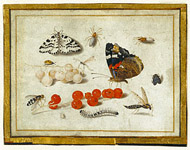Students observe live insects and examine insects depicted in a 17th-century drawing. They identify the three characteristics of an adult insect: a three-part body (head, thorax, and abdomen), six legs, and antennae. They collect and draw live insects, incorporating a variety of shapes and lines. |
 |
 |
 |
• Reproduction of Butterflies, Insects, and Currants
• Information about the featured work of art and Questions for Teaching
• Clear containers with lids with small pinholes poked in the top
• Paper, pencils, and colored pencils
• Art activity: "Drawing Insects with Organic Shapes and Lines"
|
 |
 |
 |
1. Display Butterflies, Insects, and Currants by Jan van Kessel or hand out reproductions. Tell students to look closely at the drawing and share their initial observations. Then ask students the following:
• What do you see in this drawing?
• What types of lines do you see?
• What types of shapes?
• Where do you see similar lines or shapes?
• Which objects or insects are similar to each other?
2. Inform students that before photography, scientists had to rely on drawings of natural specimens to study insects, and artists were often called upon to make these drawings. Entomological still-life painting became an important genre in Europe. Tell students to use their prior knowledge to identify the different insects they see in the drawing. Chart the names of the different insects that can be seen in the drawing.
3. Ask students for a definition of an insect and chart the
responses. Select from this list the three universal characteristics of an adult insect: a three-part body (head, thorax, and abdomen), six legs, and antennae.
4. Return to the drawing and ask, "Which of these bugs do not have the three characteristics of adult insects?" Focus on the caterpillar and ask students what they know about caterpillars. Chart responses. Explain that caterpillars are larvae for butterflies and moths. Have students identify which of the insects were once caterpillars (moth and butterfly). Explain that some insects have wings that cover their bodies (such as the fly and ladybug), but that they have the same three parts to their bodies as the other insects.
5. Have students collect insects from the schoolyard in clear containers and cover them with lids that have been poked with pinholes. Hand out paper and art supplies. Have students draw their insects, making sure to identify the three characteristics outlined above. Remind students of the lines and shapes they found when discussing the drawing by Jan van Kessel (e.g., ovals for the head and thorax, thin lines for the legs). Encourage students to draw their insects using a variety of lines and shapes. You may wish to view the art activity "Drawing Insects with Organic Shapes and Lines".
6. Release the insects back to the area in which they
were found. |
 |
 |
 |
| Butterflies, Insects, and Currants, Jan van Kessel, 1650–1655 |
 |
|
 |
Common Core Standards for English Language Arts
Grades K–5
SPEAKING AND LISTENING
K.1 Participate in collaborative conversations with diverse partners about kindergarten topics and text with peers and adults in small and larger groups.
K.4 Describe familiar people places, things, and events, with prompting and support, provide additional detail.
1.1 Participate in collaborative conversations with diverse partners about grade 1 topics and text with peers and adults in small and larger groups.
1.4 Describe familiar people places, things, and events, with relative details expressing ideas and feelings more clearly.
2.3 Ask and answer questions about what a speaker says in order to clarify comprehension, gather information, or deepen understanding of a topic or issue.
2.4 Tell a story or recount an experience with appropriate facts and relevant, descriptive details, speaking audible in coherent sentences.
3.1 Engage effectively in a range of collaborative discussions (one-on-one, in groups, and teacher-led) with diverse partners on grade 3 topics and texts, building on others' ideas and expressing their own clearly.
3.4 Report on a topic or text, tell a story, or recount an experience with appropriate facts and relevant, descriptive details, speaking clearly at an understandable pace.
4.1 Engage effectively in a range of collaborative discussions (one-on-one, in groups, and teacher-led) with diverse partners on grade 4 topics and texts, building on others' ideas and expressing their own clearly.
4.3 Identify the reasons and evidence a speaker or media source provides to support particular points.
5.1 Engage effectively in a range of collaborative discussions (one-on-one, in groups, and teacher-led) with diverse partners on grade 5 topics and texts, building on others' ideas and expressing their own clearly.
5.3 Summarize the points a speaker or media source makes and explain how each claim is supported by reasons and evidence, and identify and analyze any logical fallacies.
For more national and California state standards for this curriculum, refer to the charts found in the links at the top right of this page. |
 |

|
 |



